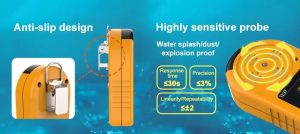Background:
We cannot live without oxygen, in industrial production, the role of oxygen is also very much, people use oxygen gas sensor to detect the concentration of oxygen.
Such as:
1. In the automobile industry, O2 sensor is used to diagnose the oxygen content in automobile exhaust gas;
2. In medical industry, O2 sensor is used to measure oxygen content in ventilator application;
3. in the power transmission environment, the use of oxygen sensor (detector) to detect the oxygen concentration of the distribution room...
In addition, oxygen gas sensors in petroleum, chemical, coal, metallurgy, paper, fire, municipal, gas emission monitoring and other industries have a very large role.
There are many types of O2 sensors, and each type of oxygen sensor has advantages and disadvantages. They are used in many applications and industries. Note that most oxygen sensors are designed to measure 0 to 25% oxygen concentration (by volume) or oxygen in breathable air.
However, there are also specialized oxygen sensors that can measure 100 percent oxygen.
The following are the specific types of oxygen sensing technologies currently in use. Note that each sensor is suitable for one or more specific applications.
Oxygen electrochemical gas sensor:
Oxygen electrochemical gas sensors are mainly used to measure oxygen content in ambient air. They measure chemical reactions within the sensor, producing an electrical output proportional to oxygen levels. Because some electrochemical sensors generate their own analog current, they are self-powered and can therefore be used to measure oxygen battery-powered underwater diving and handheld personal safety devices. Examples include ventilator, breathing sensor, and oxygen generator sensor.

In terms of the advantages of sensors, electrochemical sensors are highly sought after because of their lower power requirements, lower detection limits and less direct influence from interfering gases. They also tend to be cheap sensors.
One of the challenges faced by oxygen electrochemical gas sensors is that they rely on temperature-related chemical processes. The output of most electrochemical sensors relies heavily on temperature compensation to provide reliable readings under prevailing environmental conditions.
Another challenge with oxygen electrochemical gas sensors is that over time, chemical reactions stop, usually between one and three years, depending on the design of the sensor. Storing it in an oxygen-free environment does not extend the service life of the sensor. As the sensor ages, it requires frequent recalibration and is not as accurate as other sensors.
For example, handheld gas analyzers, JXCT is one of the manufacturers of electrochemical gas sensors for oxygen. Our sensors are widely used in gas detectors and portable safety meters. Widely used in coal mines, steel, petrochemical, medical and so on.
Fluorescent oxygen gas sensor:
Oxygen gas sensor based on fluorescence quenching principle. They rely on the use of light sources, photodetectors and luminescent materials that react to light. Luminescent oxygen gas sensors are replacing electrochemical oxygen gas sensors in many areas.
The principle of molecular oxygen fluorescence quenching has long been known. Some molecules or compounds fluoresce (emit light energy) when exposed to light. However, if oxygen molecules are present, light energy is transferred to the oxygen molecules, resulting in less fluorescence. By using a known light source, the light energy detected is inversely proportional to the number of oxygen molecules in the sample. Therefore, the less fluorescence is detected, the more oxygen molecules must be present in the sample gas.

In some sensors, fluorescence is detected twice over a known time interval. Instead of measuring total fluorescence, it measures the decrease in fluorescence over time (i.e., fluorescence quenching). This attenuation-based time approach allows for simpler sensor designs.
Oxygen gas sensor is a kind of sensor which uses the fluorescence quenching of oxygen to measure the environmental oxygen level. Although it has the same columnar structure and 4-series size as conventional electrochemical sensors, it does not absorb oxygen and has the advantage of a longer life span (five years). This makes it useful for devices such as room oxygen depletion safety alerts, which monitor sudden drops in oxygen levels in compressed gases stored in indoor air.
JXCT is introduced:
JXCT provides all kinds of O2 sensor, such as electrochemical oxygen gas sensor, fluorescent oxygen gas sensor and other different types of oxygen gas sensor, suitable for application in a variety of different environments of oxygen concentration detection. It can be widely used in oxygen portable instrument and oxygen detector. Coal mines, steel mills, petrochemical and other oxygen monitoring; Oxygen monitoring of oxygen generator, oxygen monitoring of ventilator; Fresh air system oxygen monitoring; Oxygen analysis and on-line monitoring of oxygen concentration systems.
 : +86 155 8830 2704
: +86 155 8830 2704 : jxdziot@gmail.com
: jxdziot@gmail.com
